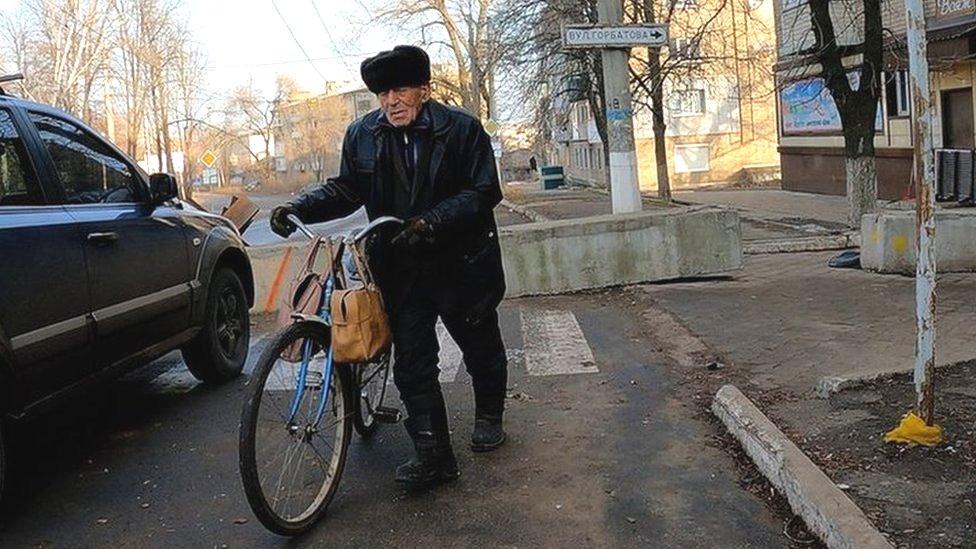Ukraine war: Western allies to send fighting vehicles to Kyiv
- Published

Germany has long resisted sending its Marder vehicle
Germany and the US have agreed to join France in sending armoured fighting vehicles to Ukraine - a move seen as a significant boost to its military's capability on the battlefield.
For months, Ukraine has been asking Western allies to supply tanks, and although these vehicles are less powerful, the decision to send them sets a new precedent.
Ukraine said it was a "great victory".
Germany has long hesitated over beefing up weapons deliveries to Kyiv.
After France's Emmanuel Macron announced on Wednesday that AMX-10 RC "light combat tanks" would be sent to Ukraine, German Chancellor Olaf Scholz and US President Joe Biden said later they too were sending armoured fighting vehicles. The US said on Friday they were part of a $3bn (£2.5bn) package of assistance.
The German leader had always emphasised that Berlin would not act alone, be it when it came to tanks or armoured fighting vehicles. The government in Berlin rejected reports that President Macron had bounced him into a decision, but some commentators in Berlin believe a taboo has been broken.
Until now, Western countries have stopped short of sending this kind of equipment, but Germany has taken part in swap deals under which Ukraine receives old Soviet tanks from Slovakia, the Czech Republic, Slovenia and Greece, which then receive more modern German equipment.
Providing Kyiv with Soviet tanks made sense as they required no extra training.
Ukrainian President Volodymyr Zelensky expressed his thanks, and deputy foreign minister Andriy Melnyk said it was merely the first taboo that needed to be broken as Kyiv wanted combat aircraft, warships and more.
Allow X content?
This article contains content provided by X. We ask for your permission before anything is loaded, as they may be using cookies and other technologies. You may want to read X’s cookie policy, external and privacy policy, external before accepting. To view this content choose ‘accept and continue’.

The $3bn US package is reported to include as many as 50 Bradley fighting vehicles. The Pentagon said the Bradley was not a tank, but a "tank killer".
The White House said it would take some time before they arrived in Ukraine. The funding is also expected to include self-propelled howitzers, mine-resistant vehicles and GMLRS precision rockets while $682m is be given to allies on Nato's Eastern flank.
Germany is sending around 40 Marder infantry fighting vehicles by the end of March as well as a Patriot anti-aircraft missile system. A government spokesman said training would take place in Germany over eight weeks.
Together, the three types of armoured fighting vehicle will give Ukrainian forces firepower, mobility and survivability, to get troops into front-line positions with speed and protection. That will enable them to react quickly to a dynamic, developing battlefield.
The French AMX-10 RC is similar to a tank in that it has a 105mm cannon, but unlike the French Leclerc tank, it runs on wheels rather than tracks. Specialist engineer Marc Chassillan told Le Monde newspaper it was a good all-terrain vehicle and a "perfect watchdog" alongside armoured personnel carriers and ground infantry.


The Bradley armoured unit will provide Ukraine's military with additional firepower. It has a Bushmaster 25mm cannon and can fire both explosive and armour-piercing rounds.
It can carry up to 10 people and the US Army has used it to carry troops around battlefields since the 1980s.


Pentagon spokesman Brig Gen Pat Ryder said it would support both offensive and defensive operations.
The Marder fighting vehicle has been used by the German army since the 1970s. It has a 20mm calibre cannon that can hit helicopters as well as tanks over a range of 1,500m (5,000ft). Although it dates back 50 years, the Marder has been repeatedly modernised and latest models enable soldiers to use the vehicle at night with thermal imaging cameras.
The German army is replacing its ageing stock with Puma infantry fighting vehicles, but still has some 370 Marders, although many need to be refurbished.
There was near-unanimous support for the German move, and the head of the Bundestag's defence committee, Marie-Agnes Strack-Zimmermann, said it was "very late, but not too late". She said she would not give up pushing for Leopard 2 tanks to be sent too: "After the Marder, it'll be the Leopard."
German Foreign Minister Annalena Baerbock made clear that Ukraine had to be given weapons "to free occupied areas and the people who are suffering under Russian terror".
Related topics
- Published4 January 2023
